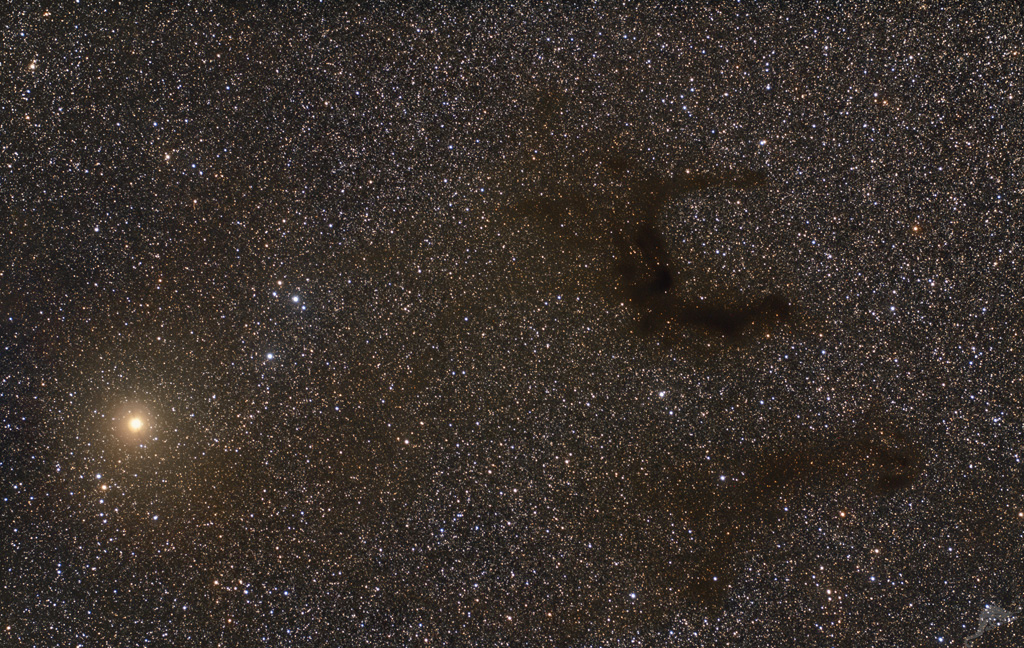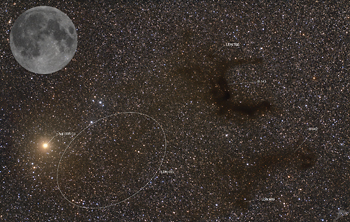 |
CHAMÄLEON + ONJALA OBSERVATORY DeepSky | SITEMAP HOME CHAMÄLEON |
|
 |
|||
| « back to overview Nebula | Load higher resolution (1800 x 1200 Pixel 3500 x 2300 Pixel) | Object description |

The dark nebula Barnard 143 in the constellation Eagle forms together with the below lying dark cloud Barnard 142 the so called E-nebula. These are dark and cool clouds of dust and molecules, which strongly weaken or completely block the light of the stars behind them. Both dark clouds are located about 2000 light years away from the solar system. The bright star on the left side of the image is Gamma Aquila (Tarazed) in the head of the eagle.
Edward Emerson Barnard (1857 - 1923) was self-taught and a pioneer of astronomical photography. With the assistance of Simon Newcomb, he received a stipend to study at Vanderbilt University, graduating at the age of 30. During this time he also supervised the Vanderbilt University Observatory there. In 1888 he became a staff member at the newly established Lick Observatory, and in 1897 Barnard moved to the Yerkes Observatory under the direction of George Ellery Hale.
Beginning in January 1905, Barnard began a large-scale photographic sky survey at Mount Wilson Observatory with the 10-inch Catherine-Bruce double astrograph, and by late summer he had produced 480 images of excellent quality and another 3500 images in subsequent years. They became the basis of his discovery that dark regions in the Milky Way are not due to a void of stars, but on the contrary that there are finely distributed extended dust masses that absorb the light of the stars behind them. As a result, he created his catalog of such dark clouds - the Barnard Catalog of Dark Nebulae.
His entire dark nebula catalog (370 objects in total) can be found online here, and at this URL there is - also online - Barnard's "Photographic Atlas of Selected Regions of the Milky Way."
In 1916 Barnard discovered a fixed star with enormously large proper motion - Barnard's Star. With a distance of 5.94 light-years it is the second closest fixed star to our solar system after Proxima Centauri. Images of Barnard's star and its proper motion from us are shown here.
 |
In
2018, ESO announced the discovery of "a super-Earth" orbiting Barnard's Star.
More info from ESO
can be found here. Furthermore Barnard discovered photographically the large emission nebula enveloping the Orion complex (Barnard's Loop), as well as Barnard's galaxy named after him in the constellation Sagittarius, the near dwarf galaxy NGC 6822. A picture of us with information of NGC 6822 we show here. Furthermore, craters on the Moon, Mars and Jupiter's moon Ganymede, as well as the asteroid Barnardiana (discovered by Max Wolf in 1916) are named after Edward Emerson Barnard. « Click here or the thumbnail to load a large annoted image and a size comparison to the full moon. |
 |
 |
 |
 |
 |
 |
 |
| Sun | Moon | Solar System | DeepSky | Widefield | Miscellaneous | Spec. Projects |